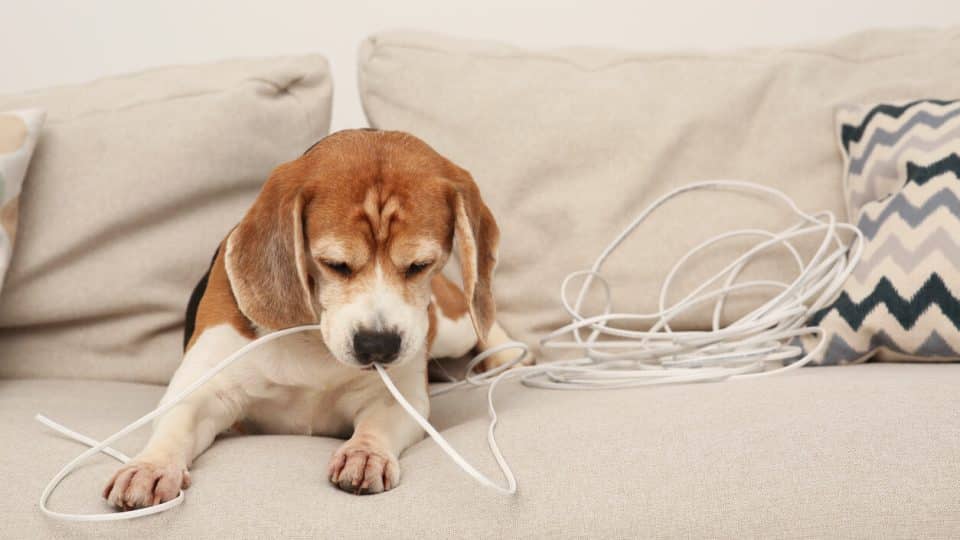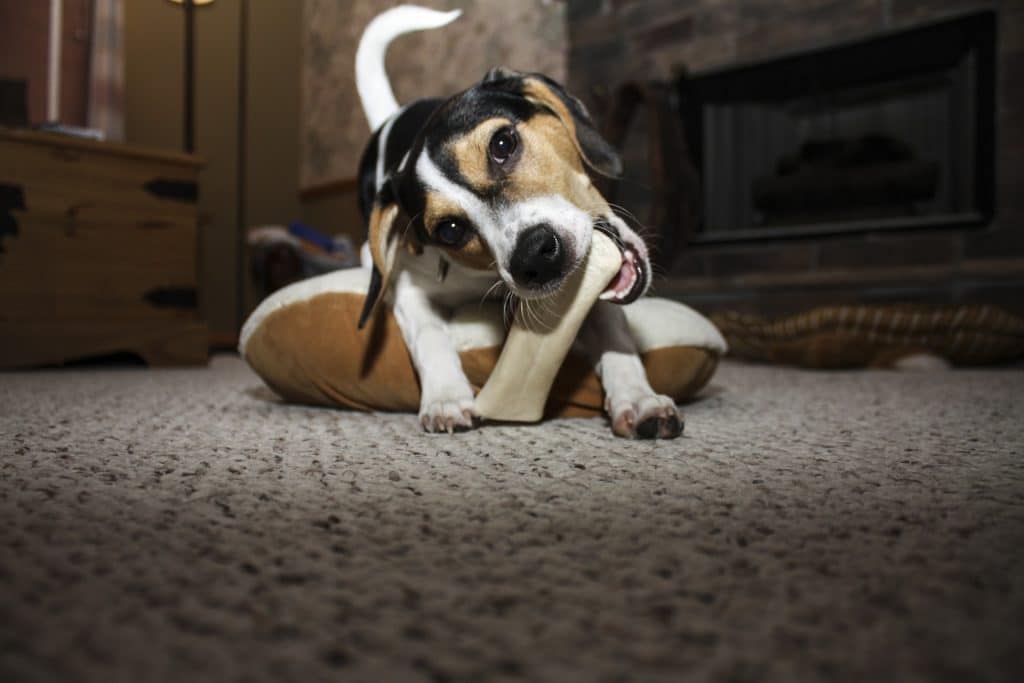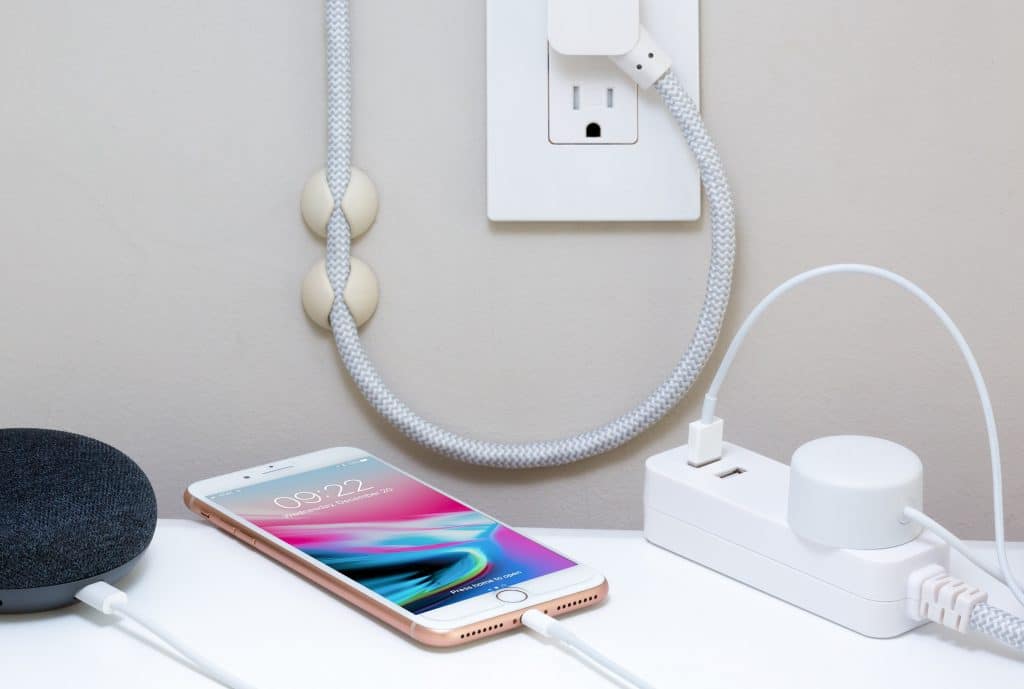Dogs—especially puppies—like to chew, but how can you prevent dogs from chewing electrical cords and other dangerous items? The chewing comes as no surprise to us dog lovers. Some pups outgrow it. Others don’t.
It took a decade for my 13-year-old Corgi-Chi mix, Parker, to let go of his chewing obsession.
I adopted him at age two, and he spent the next 10 years of his life finding and destroying shoes. Now he just moves them from the front door to his bed. If he’s feeling ambitious, he may untie the laces.
Although I said goodbye to many shoes over a decade, there are other inviting “chewables” that pose a real threat to your dog’s well-being and life: electrical cords, wires, and cables.
The danger of your dog chewing on electrical cords
When your dog gnaws on power cords, it can result in serious injuries and even death. Here are the signs that your dog was shocked while chewing on wires or cables:
- Burns around the mouth or singed fur
- Shortness of breath
- Rapid heart rate
- Muscle tremors
- Seizures
- Physical collapse
If you know or suspect your dog is suffering from electrical shock, shut off the electricity to that cord immediately.
Do not touch your pet if you can’t turn off the electricity—you could get electrocuted too. Instead, use something wood-based to move your dog off the power cord.
Why are dogs attracted to power cords?
Anything within your dog’s reach is fair game for chewing. Electrical cords are usually right at their level.
They also have a familiar appearance. From your dog’s perspective, power cords look a lot like chew sticks, which look a lot like bones. Nom-nom!
Why do our besties chew in the first place?
Before we dive into how to stop your beloved dog from gnawing through cords and wires, it’s important to understand why they chew at all.
Depending on the stage of your dog’s life, there are different reasons for chewing. Puppies do it as a way to relieve the pain of teething. Grown dogs chew to keep their jaw strong and teeth and gums healthy.
Chewing is also a coping mechanism for some dogs. It can help alleviate boredom, frustration, and anxiety.
Ways to prevent your dog from chewing electrical cords
There are a variety of tactics to put into play to help keep your dog away from power cords.
Hide power cords.
When Parker’s shoe obsession started years ago, I quickly learned to put my shoes away. Out of sight, out of mind. The same strategy applies to power cords.
Here are some ways you can remove electrical cords and wires from your dog’s view:
- Hide electrical cables and chargers behind furniture.
- Run cables and wires around doorways.
- Store power strips, cords, cables, chargers, and adaptors in cable management boxes.
- Use cable ties and hooks to keep cords off the floors and flush against the walls.
Block access to electrical cords.
You might have cords that your dog is interested in that you can’t hide. There are a few blocking tactics you can try when you’re not at home to keep an eye on your dog.
- Close the door to the room with the cords your dog likes so much.
- Put up a pet gate. Make sure it’s high enough so your dog can’t jump over it!
- Keep your pal safe in a crate.
Spray taste deterrents on cords.
Apply bitter or spicy-hot tasting sprays on cables to make them unappealing to dogs. It might be a good idea to test your dog’s reaction first. WebMD explains that some dogs are totally grossed out by the tastes, while others slurp up the flavours.
Train your dog to leave it.
The “leave it” command is helpful, powerful, and versatile. It can apply to both moving and non-moving objects, either indoors or outdoors. Teach your dog “leave it” in 8 steps to deter interest in power cords.
Watch and redirect your dog’s interest.
If your dog is a fan of a power cord that you can’t relocate, try to divert his or her attention. Supervise, catch your dog in the act of nibbling the cord, and give your dog an enticing alternative like a bully stick.
Give your dog chewing options.
Along the same lines of redirecting your dog’s interest in power cords, try presenting your dog with a few different choices for his or her gnawing entertainment.
A bully stick might stimulate for a while, but your dog may lose interest.
Try interactive toys. You can fill many of them with treats or peanut butter, which is both exciting and rewarding for your pal. Just be careful of toys that may pose a choking hazard, like plush ones with stuffing and squeakers.
Different strokes for different dogs
Just like humans, not all canines are alike. Your dog may respond differently to the techniques listed above from your neighbour’s dog. Try them all and see what sticks.





